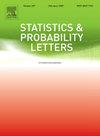广义逆高斯的性质及其在蒙特卡罗模拟和分布函数评价中的应用
IF 0.9
4区 数学
Q3 STATISTICS & PROBABILITY
引用次数: 0
摘要
本文介绍了广义逆高斯分布的两种混合表示。一种混合表示将GIG表示为逆高斯函数的连续混合。另一个揭示了GIGs之间的关系。这些混合表示导致了新的采样方法和一种精确的算法来评估半整数p的GIG分布函数。本文章由计算机程序翻译,如有差异,请以英文原文为准。
Properties of the generalized inverse Gaussian with applications to Monte Carlo simulation and distribution function evaluation
We introduce two mixture representations for the generalized inverse Gaussian (GIG) distribution. One mixture representation expresses the GIG as a continuous mixture of inverse Gaussians. The other reveals a relationship between GIGs. These mixture representations lead to new sampling methods and an exact algorithm for evaluating the distribution function of the GIG for half-integer .
求助全文
通过发布文献求助,成功后即可免费获取论文全文。
去求助
来源期刊

Statistics & Probability Letters
数学-统计学与概率论
CiteScore
1.60
自引率
0.00%
发文量
173
审稿时长
6 months
期刊介绍:
Statistics & Probability Letters adopts a novel and highly innovative approach to the publication of research findings in statistics and probability. It features concise articles, rapid publication and broad coverage of the statistics and probability literature.
Statistics & Probability Letters is a refereed journal. Articles will be limited to six journal pages (13 double-space typed pages) including references and figures. Apart from the six-page limitation, originality, quality and clarity will be the criteria for choosing the material to be published in Statistics & Probability Letters. Every attempt will be made to provide the first review of a submitted manuscript within three months of submission.
The proliferation of literature and long publication delays have made it difficult for researchers and practitioners to keep up with new developments outside of, or even within, their specialization. The aim of Statistics & Probability Letters is to help to alleviate this problem. Concise communications (letters) allow readers to quickly and easily digest large amounts of material and to stay up-to-date with developments in all areas of statistics and probability.
The mainstream of Letters will focus on new statistical methods, theoretical results, and innovative applications of statistics and probability to other scientific disciplines. Key results and central ideas must be presented in a clear and concise manner. These results may be part of a larger study that the author will submit at a later time as a full length paper to SPL or to another journal. Theory and methodology may be published with proofs omitted, or only sketched, but only if sufficient support material is provided so that the findings can be verified. Empirical and computational results that are of significant value will be published.
 求助内容:
求助内容: 应助结果提醒方式:
应助结果提醒方式:


